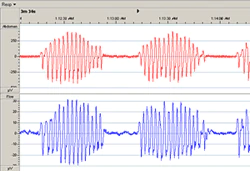Heart failure is a growing problem worldwide that rises with age, and is estimated to affect 6-10% of people aged over 65.1
Up to 73% of patients with stable heart failure experience sleep-disordered breathing (SDB),2 with Cheyne-Stokes respiration (CSR), obstructive sleep apnea (OSA) or central sleep apnea (CSA).
CSR occurs when periods of hyperventilation and hypoventilation, in a waxing and waning breathing pattern, alternate with periods of central hypopnea and apnoea.
CSR has been found to be a highly prevalent form of SDB in patients with severe left ventricular dysfunction.3

Nocturnal CSA/CSR is associated with increased mortality4 in CHF patients.
CSR may accelerate the progression of heart failure by causing:
Fragmented sleep resulting from CSR also causes fatigue which impacts quality of life.6
Joseph et al. Acute Decompensated Heart Failure Tex Heart Inst J. 2009
Ferreira S, et al. Prevalence and characteristics of sleep apnoea in patients with stable heart failure: Results from a heart failure clinic. BMC Pulm Med.2010, 10:9
Lanfranchi PA, et al. Central sleep apnea in left ventricular dysfunction. Prevalence and implications for arrhythmic risk. Circulation 2003, 107: 727.
Javaheri S, et al. Central sleep apnea, right ventricular dysfunction, and low diastolic blood pressure are predictors of mortality in systolic heart failure. J Am Coll Cardiol. 2007, 49(20):2028-34.
Garcia-Touchard A, et al. Central sleep apnea: implications for congestive heart failure. Chest. 2008, 133(6):1495-504.
Bradley TD et al Sleep Apnea and Heart Failure Part II: Central Sleep Apnea Circulation 2003;107:1822-1826